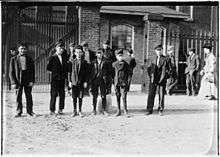Cocheco Mills
|
Cocheco Mills | |
|
Mill #1 | |
| Location | Main and Washington Sts., Dover, New Hampshire |
|---|---|
| Area | 11.5 acres (4.7 ha) |
| Built | 1822 |
| NRHP Reference # | 14000081[1] |
| Added to NRHP | March 26, 2014 |
The Cocheco Mills are a historic mill complex in the heart of Dover, New Hampshire. The mills occupy a site at a bend in the Cocheco River that has been the site of industrial activity since at least 1822, when the Dover Cotton Factory was built there. The present mill buildings were built between the 1880s and the early 20th century,[2] and were listed on the National Register of Historic Places in 2014.[1]
Description

The surviving elements of the mill complex are six major manufacturing buildings, the dam and wheel house which diverted water to the mills, a steel bridge, and the smokestack and remains of the boiler house of the complex.
Dam, wheel house and bridge
The dam stretches across the Cocheco River in a broad arc roughly west of mills #2 and #3. It is made of rough-cut granite ashlar, and stands between 9 and 150 feet in height. It has a modern concrete spillway. The dam was built sometime between 1905 and 1925, replacing an earlier dam. The wheel house stands east of mill #2, and is a small single-story brick structure built on a concrete arch which spans the space between mill #2 and the river. The bridge is a steel truss structure spanning the river west of mill #3. Probably built in the 1880s, it has wooden decking and a decorative balustrade.[2]
Mills
There are four main mill buildings in the complex. The #1 mill is a five-story brick building located south of Washington Street. It was built in 1908 after the previous #1 mill was destroyed by fire; portions of the older structure that survived the fire were supposedly reused in its construction. The 1880 #2 mill marks the northern end of the complex, and is located between Main Street and Central Avenue. It is a four-story brick structure, and is joined at the south end to mill #3, which was built in 1881 and actually spans the river. An L-shaped extension added in 1909 replaced the old #4 mill. The #5 mill, built in 1825, is the oldest surviving element in the complex. Originally 25 bays in length, a portion of the building was demolished in the mid-20th century, leaving the present 10 bays. It has a distinctive Gothic Revival tower to which a belfry was added in the 1850s.[2]
Picker houses
There are two picker houses, both built between 1905 and 1925. The #1 house is adjacent to the #1 mill at the south end of the complex. It is a brick structure three stories tall and roughly 12 bays long and 8 wide. It is joined to the #1 mill by a pair of two-story enclosed bridges. The #2 house is at the north end of the complex; it is a brick structure three stories tall, although because of the site topography one facade only shows two stories. Also 12 by 8 bays in dimension, it was once connected by an enclosed bridge to mill #2, but this has been removed.[2]
History
The mills were operated by the Cochecho Mill Company until 1909, when the plant was purchased by Pacific Mill Works of Lawrence, Massachusetts. In addition to textile processing, Pacific operated the Cocheco Print Works on the premises. Competition from textile processors in the American South, combined with the effects of the Great Depression led Pacific to shutter the complex in 1937. The city purchased the complex at auction in 1940. The buildings have since been home to a succession of smaller enterprises, primarily engaged in manufacturing.[2]
See also
References
| Wikimedia Commons has media related to Cocheco Mills. |
- 1 2 National Park Service (2010-07-09). "National Register Information System". National Register of Historic Places. National Park Service.
- 1 2 3 4 5 "NRHP nomination for Cocheco Mills" (PDF). National Park Service. Retrieved 2014-08-03.

